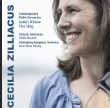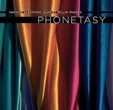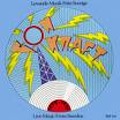< List of works / Listen and watch >
Concerto for Double-bass and orchestra, ¨Lost Birds¨, Niek de Groot, soloist, Kyiv Symphony Orchestra, cond. Luigi Gaggero.
From the booklet: ¨The title 'Lost Birds' was inspired by the sound of the Contrabass and its rare role as a solo instrument in a concert, but also inspired by the opening track of the King Crimson album, ¨Islands¨, a favourite music of my youth.
Each of the moments is dedicated to some extinct bird species, which is portrayed in the three movements; the Dodo bird (Raphus cucullatus) in the first movement and the Kauai-oo Bird (Moho braccatus) in the second movement, which is based on the recording of the last male’s mating call in 1987.
In the third movement the gigantic Moa Bird (Dinornithidae) is portrayed.
The special character and the nature of melancholy of the sound of the Contrabass suited well for these portraits.¨ (Anders Nilsson)
¨Requesting Anders Nilsson to compose a double-bass concerto for me, was a natural process. When I came across his fantastic violin concerto and symphonies, it was immediately clear to me that his idiom seemed very suitable. A concerto in which a real and constant dialogue would arise between the orchestra and double bass has been extremely rare until now. I was very pleased that he took up the challenge.
Anders seemed to understand immediately and without further explanation what the power and characters of the instrument are, as well the technical strengths and challenges. Hardly any adjustments had to be made after I received the first score. It was absolutely right.¨ (Niek de Groot)
 Tillgänglig på Spotify:
Tillgänglig på Spotify:  Västerås Sinfonietta performs Symphony IV, Zarah Suite (dir. Eva Ollikainen), Piano Concerto (soloist Martin Sturfält, cond. Gabor Takàcs-Nagy) and ¨Chaconne¨ f. solo piano (Sturfält)
Västerås Sinfonietta performs Symphony IV, Zarah Suite (dir. Eva Ollikainen), Piano Concerto (soloist Martin Sturfält, cond. Gabor Takàcs-Nagy) and ¨Chaconne¨ f. solo piano (Sturfält) Violin Concerto with Cecilia Zilliacus, Västerås Sinfonietta, cond. Fredrik Burstedt (db-Productions)
Violin Concerto with Cecilia Zilliacus, Västerås Sinfonietta, cond. Fredrik Burstedt (db-Productions) HagaDuo (Sareidah Hildebrand, fl. och Joakim Lundström, git.) performs ¨¨Ballade¨ f. altflöjt och gitarr.
HagaDuo (Sareidah Hildebrand, fl. och Joakim Lundström, git.) performs ¨¨Ballade¨ f. altflöjt och gitarr.  CD with the Uppsala Chamber Soloists, performing ¨Höst¨ (Autumn) for string sextet (2004). Phono Suecia PSCD 190
CD with the Uppsala Chamber Soloists, performing ¨Höst¨ (Autumn) for string sextet (2004). Phono Suecia PSCD 190 ¨Phonetasy¨ performed by the saxophone quartet Rollin’ Phones, together with pieces by Samuelsson, Breman, Jansson, Söderberg, Levander
¨Phonetasy¨ performed by the saxophone quartet Rollin’ Phones, together with pieces by Samuelsson, Breman, Jansson, Söderberg, Levander¨Six composers are represented on this new CD, starting with Anders Nilsson's brilliant piece that gave the disc its name, Phonetasy. Some echoes of Stravinsky and minimalism combined with Nilsson's distinctive musical language makes Phonetasy into yet another masterpiece from him. Great vivid and beautiful music¨(OPUS)
Anders Nilsson's Phonetasy is a good choice to open the programme. It is inventive, varied and marvellously lyrical, with many moments of real beauty¨ (Musicweb-international rewiews - March 2011)
¨The first work is in my view the most original and entertaining on the disc, that is the trio of Nilsson. The opening ‘Foxtrot’ is like no other you will ever meet but it is bright and rhythmic. It is followed by a ‘Habanera’. They makes some attempt at the typical dotted crotchet rhythm and a closing, exciting Rondo. The music has an inner life and vitality which is most appealing.¨ (Classical CD Reviews- Aug 2002 MusicWeb(UK/Gary Higginson)
 Ilona Maros, sopr. Bengt Forsberg, org.: Aria, and music by bl.a. Mellnäs, Maros, Eklund. (Phono Suecia)
Ilona Maros, sopr. Bengt Forsberg, org.: Aria, and music by bl.a. Mellnäs, Maros, Eklund. (Phono Suecia) The Raschèr Saxophone Quartet och The Swedish Chamber orchestra: Concerto grosso I and other concertos by Wuorinen, Hvoslef and Kaipainen (BIS)
The Raschèr Saxophone Quartet och The Swedish Chamber orchestra: Concerto grosso I and other concertos by Wuorinen, Hvoslef and Kaipainen (BIS) ¨The Concerto grosso by Anders Nilsson (b. 1954) is the most traditionally structured of the three, written in three distinct movements, fast-slow-fast, with the quartet used very much in the manner of a latter day version of the concertino in a Baroque concerto grosso. The soloists play music with a kind of chunky, clownish, even impish quality—as if their collective exuberance cannot be tamed, even within the confines of the nominally slow middle movement. In its constant virtuosity and polyphony, as well as its diatonic if not especially tonal harmonic language, it could well call to mind the more concentrated work of the later Ligeti. It is a genuinely splendid work.¨ (Fanfare Magazine Issue 27:5 May/June 2004 John Story)
¨Several years ago, I found a second-hand copy of a Swedish disc (Phono-Suecia PSCD 53) entirely devoted to works by Anders Nilsson, a name then completely new to me. I found the music very appealing. I was delighted to hear one of his recent works on this disc. It happily confirms my earlier impressions. His music was aptly described by Thomas Roth (in his insert notes for the above-mentioned disc) as "full of the joy of being alive". In fact, as is the case with many younger Scandinavian composers, Nilsson’s background lies in the field of popular music in which he was active in his early years and from which he gained a refreshingly undogmatic approach to music, although there is nothing amateurish about his music. His Concerto grosso falls into three movements on the fairly traditional fast-slow-fast pattern (although the central slow movement is at times quite animated). There are several cyclical elements which help to maintain formal and thematic coherence (most themes re-appear in the final movement Allegro e corrente, a perpetuum mobile in all but the name).
At first, Nilsson’s music may give the impression that it is largely improvised; but it is actually carefully and fully worked-out although it maintains some improvisatory
quality. Nilsson has a remarkable flair for arresting orchestral textures, already quite in evidence in some of the pieces on the Phono-Suecia CD (e.g. his superb Organ Concerto) and amply confirmed in this extrovert often playful piece that in spite of its plain title deliberately turns its back on Baroque models.¨ (Classical CD Reviews- March 2004 MusicWeb(UK) Hubert Culot)
.
 Anders Kilström: Les cloches de la nuit and other pianoworks by Hammerth, Martinsson; Lindgren (Daphne Records)
Anders Kilström: Les cloches de la nuit and other pianoworks by Hammerth, Martinsson; Lindgren (Daphne Records)¨His beautifully impressionistic Les Cloches de la Nuit inspired by a stay at the well-known Mont Saint Michel in France is a most welcome addition to his discography. It is a really fine piece that clearly deserves wider exposure.¨ (Classical CD Reviews- September 2005 Hubert Culot)
 Lux Aeterna (1994), Erik Westberg's Vocal ensemble. Carl-Henrik Fernandi, soprano saxophone, Mattias Wager, organ. (Studio Acusticum, also available on iTunes and Spotify)
Lux Aeterna (1994), Erik Westberg's Vocal ensemble. Carl-Henrik Fernandi, soprano saxophone, Mattias Wager, organ. (Studio Acusticum, also available on iTunes and Spotify)
 Urworte - Orphisch (Goethe) Erik Westbergs vokalensemble
Urworte - Orphisch (Goethe) Erik Westbergs vokalensemble
In addition also on the following LP-records:
Swedish Pianorama: Rèsonance (Kenneth Karlsson,pf.) Caprice
and as rock-musician in a band called ¨Östan Sol Västan Måne¨ in the 70's: (Silence Records)
(Silence Records) (SR Records)
(SR Records)